History of Providence Row
Contributed by Survey of London on Jan. 9, 2019
This history of Providence Row, which provides shelter and services to the homeless, is from an information brochure by Providence Row which they contributed to this project in October 2018;
The Early Years
In the winter of 1857, a young Catholic priest, Father Daniel Gilbert, came across a woman sheltering in a doorway in London’s East End, an area notorious for its poverty and deprivation. He struck up a conversation with her and discovered that she had no money and nowhere to go. He was so moved by this unfortunate woman’s situation that he resolved to create a refuge for people like her, open to anyone regardless of their background, race or religion.
Fr Gilbert called on the help of the Sisters of Mercy in Wexford, Ireland. On the 23rd of September 1858 five of the Sisters arrived in London. Initially they moved to a convent on Broad Street but found it too small for the purposes of a refuge. Fr Gilbert then found a large stable at the back of 14 Finsbury Square. This stable opened on to a narrow street called Providence Row.
After less than a month of dedicated, hard work and fundraising by the small group of founders Providence Row Night Refuge opened on 7th October 1860. It was the first non sectarian shelter in London. Originally it contained only 14 beds but quickly expanded in February 1861, adding another 31 beds 1. This still didn’t prove big enough to meet the demand and the refuge later moved to a larger site on Crispin Street, near Spitalfields Market. By 1862 it had provided 14,785 meals to homeless and destitute people in London 2.
By the time of his death in 1895, the now Monsignor Gilbert had raised and spent an enormous £100,000 on the refuge, putting up new buildings and improving and expanding the services on offer. Remarkably, he had paid back all the loans he had secured to fund the refuge 3. His death was not the end of the Gilbert family’s involvement in Providence Row however. Monsignor Gilbert’s nephew, J W Gilbert, joined the management committee in the same year. Many years later Monsignor Gilbert’s great nephew would become the warden for the men’s hostel and his skills in repairs and maintenance would save the refuge a great deal of money over the years 4.
Providence Row offered a welcome alternative to the only other free accommodation available to homeless and destitute people at that time: the workhouse. For those that found themselves in difficulty the workhouse was a humiliating last resort. Families were broken up and rather than looking for work outside ‘inmates’ were forced to pick old ropes apart to make ‘oakum’ (a waterproofing material) or other menial tasks. Once in the workhouse one rarely found a way out.
Providence Row’s refuge was not in this vein. Families were kept together, although the men had to sleep in separate quarters. Later, self-contained flats for entire families would be built to help maintain family units. The Sisters of Mercy ran a school attached to their convent in Crispin Street enabling mothers and fathers to look for work during the day while their children were cared for. The Sisters’ continuous cooking, cleaning and general upkeep of the refuge gave people time to look for work by reducing the time needed for domestic chores. Between the world wars, the refuge even provided professional singers, actors and artists to entertain clients.
The period between 1918 and 1939 also saw a greater dialogue by government and local authorities about the issues that surrounded poverty and destitution. It also saw an influx of European immigrants fleeing Nazi persecution; an estimated 30,000 European Jews came to England in the 1930s alone. It was left to organisations such as Providence Row, as well as other local groups founded by their fellow countrymen, to help these new arrivals.
World War II
The advent of World War II changed Providence Row in many ways. By 1939 the charity ran five refuges, with plans to develop further. However, the annual report for that year notes that these plans would need to be put on hold and set out the modified purpose for the war, ‘as a rest and feeding centre for people who might be rendered homeless by enemy bombing operations 5’ alongside their existing work of helping homeless people. The men’s common room was converted into an air raid shelter and the charity became part of the National Defence Scheme. These provisions would be well used throughout the war as a refuge for those made homeless by the bombings, the so-called ‘housing famine’.
At the end of the war the charity saw a change in its client group. Before the war those staying at the refuges had generally been men of working age experiencing temporary difficulties. The outbreak of war, and specifically conscription, provided employment to many young men and in turn enabled older men to find work more easily. At the charity this shift meant a rise in under- 20s awaiting the call to service and more people who were elderly or ill. The charity also noted a rise in men suffering mental illnesses as a direct result of the bombings 6.
The true horror of war came home even further in 1940 when the refuge and offices at Milk Street and Mark Lane were bombed 7. Due to the heavy bombing in the East End the refuge eventually closed in 1942 and only reopened after the war 8.
After the war
1948 brought the National Assistance Act and with it the end of the Poor Law that had dominated nineteenth century attitudes to the homeless. The last workhouse closed in 1929; the shift towards the welfare state had begun 9. The management committee and Sisters of Mercy at Providence Row now presumed their work was done and that the refuge would become ‘redundant’ 10. However, on this matter they were wrong. The Act did not go far enough to helping those who found themselves destitute and, due to public misunderstanding of the Act, donations to the charity decreased.
Providence Row and the services it provided were needed more than ever, but with a much tighter budget. Aside from its usual client group, the refuge was also seeing people who had been rendered homeless by the bombing – homes that for many were not rebuilt until the 1950s.
From its beginning in 1860 through to the mid 1970s, caring for destitute families was a priority for Providence Row. Ken Loach’s influential 1966 television play Cathy Come Home helped to highlight the plight of such families, and around this time provision for these families began to gradually improve. Seeing this increase in help specifically for families, along with a range of new and alternative advice and service centres, Providence Row began to shift its focus towards helping those people not being prioritised by the welfare state; single homeless people and those without children.
A Time of Change
The 1970s was a period of great change for Providence Row. A decline in charitable giving and a rise in running costs meant Providence Row needed to reassess and modernise 11. Paid staff were introduced to work alongside the Sisters of Mercy and in 1970 the application to the National Federation of Housing Societies to create a Providence (Row) Families Housing Association was approved. In 1988 Providence Row Charity and Providence Row Housing Association separated and became two different organisations. This enabled those at the charity to concentrate on the day centre services it had begun to provide. Luckily for the charity, the Sisters of Mercy felt the work they did was traditionally more aligned with the charity and most chose to stay there, rather than join the housing association 12. A team of dedicated volunteers from the Sisters of Mercy still play a crucial part in delivering services at Providence Row today.
In the 1970s and 1980s there was a period of regeneration and redevelopment in the East End and local papers began to report on the archaic state of housing in Spitalfields, an area mostly unchanged for over 100 years.
After the 1988 separation from the housing association, the decision was made to move from Crispin Street to a new site. A fundraising campaign began and - with the help of the Sisters of Mercy who sold the Crispin Street site in aid of the campaign - the Dellow Centre was built. It opened on 17 April 1994 13. Around this time Providence Row had integrated with two other organisations: St Botolph’s and the Just Ask Counselling Service. These two merges meant that Providence Row was able to begin expanding the services it offered as well as access to funding from central government. These factors enabled the charity to modernise and keep up with sector trends.
The Present
Providence Row continues to offer day centre services to people affected by homelessness in the East End of London.
We’re a one-stop shop of advisory, recovery and training opportunities for those who need it most. Our team supports people with housing, money, health and substance misuse issues. Meanwhile our learning and wellbeing activities help people renew skills, confidence and healthier relationships with the people in their lives. Finally our catering, gardening and baking training schemes are a fun, structured and supportive way of getting a qualification, building their CV and getting back into work.
Website address www.providencerow.org.uk
Providence Row currently has 30 full time staff and around 30 dedicated volunteers. We continue to help people from all backgrounds and walks of life, and unfortunately there remains a desperate need for our services in the 21st century.
-
Procter, A.A., A Chaplet of Verses, London, 1862, p.ix. ↩
-
Ibid, p.x. ↩
-
Providence__ Row: 1860-1960, commemorative centenary document produced inhouse, 1960. ↩
-
Management Committee Meetings, 5 October 1966, p.185. ↩
-
The Seventy-Ninth Annual Report of the Providence (Row) Night Refuge and Home, p.8. ↩
-
Ibid, 22 April 1942, p11. ↩
-
Ibid, 19 September 1940, 17 October 1940, 10 May 1941 (check pages). ↩
-
Ibid, 22 April 1942, p.11. ↩
-
Source: http://eastlondonhistory.com/tag/workhouse/ ↩
-
Providence Row Night Refuge and Home for homeless men, women and families, pamphlet produced in house c.1950. ↩
-
Background to the charity and Dellow Centre, internal report produced in house, c.1996. ↩
-
Providence Row internal report, produced in house, 1989, p.??. ↩
-
Providence Row Appeal, commemorative book, 1994. ↩
82 Wentworth Street (Dellow Centre)
Contributed by Survey of London on Aug. 27, 2019
The brown-brick building running from Wentworth Street south down the east side of Gunthorpe Street is the Dellow Centre, opened in 1994 by Providence Row, a charity that provides shelter and services to the homeless. It occupies the northern part of the site that was the George Yard Council Depot, the Wentworth Street frontage of which was rebuilt on a set-back line in 1902–3.
Providence Row’s origins are in a night shelter opened in 1860 by Father Daniel Gilbert, a Catholic Priest, with the assistance of several Sisters of Mercy from Wexford, in a converted stable overlooking Providence Row, behind Finsbury Square. It moved in 1868 to Crispin Street in Spitalfields, to provide free accommodation and meals to destitute families for up to six weeks. A school freed parents to look for work. The Crispin Street premises remained open into the 1980s, by which time the establishment’s focus was on the single homeless. In 1988 Providence Row split into a charity and a housing association. It was felt that more good could be done further from the City than Crispin Street and the valuable site was sold. The charitable arm of Providence Row, now merged with two charities with complementary aims, St Botolph’s and the Just Ask Counselling Service, acquired the northern part of the former George Yard Depot. In 1991 planning permission was granted for new buildings designed by Aukett Limited, architects. Work began in August 1992 with Alfred McAlpine as contractors, and the centre opened on 17 April 1994.
The building is on a similar footprint to that of those along Gunthorpe Street it replaced, the site being entered from Wentworth Street. The complex had three sections when it opened. At the north end, the Dellow Centre comprised ground-floor reception, interview, consulting, treatment and dining rooms and offices for the charity, with upper-storey night refuge for thirty people consisting of five-room clusters sharing lounges and bathrooms. In the middle, Bartlett House was five two-bedroom flats below a second-floor women’s hostel with eight _ensuite _bedrooms for the Providence Row Housing Association. At the south end, McAuley House was a ten-bedroom convent for the Sisters of Mercy, with a community room, sacristy and chapel on the third floor.
The whole building is clad in brown brick with occasional red-brick courses and grey-sheet-clad attics. The Wentworth Street façade extends an extra bay eastwards with a semi-open screen wall to enclose the courtyard. There are neo-Georgian allusions typical of the mid-1990s in the full-height bows north and south and the projecting eaves. A single-storey arts and activity centre, fully glazed and semi-circular in plan, was built on the east side of the yard.1
Need for the charity’s day services increased and alterations were made in 2005 by the same architects, now Aukett Fitzroy Robinson, to expand the day centre across the ground floor of all three sections of the building, also providing space for twenty partner organisations. The flats in Bartlett House were converted to bedsits with _ensuite _bathrooms, reflecting the preferences of residents who stay for up to two years. A gatehouse and decorative steel gates were added on Wentworth Street, and a large array of solar panels on the roof.
In 2011–12 a three-storey arts and activity day centre was slotted into a square space on the east side of the courtyard behind Universal House. Designed by Featherstone Young, it won an RIBA award. With perforated corrugated-iron façades in shades of green, it features a cantilevered first floor, faced in off-white cement board with an irregular zigzag profile that underlies a second-floor balcony. There is a bicycle workshop with an art studio, performance space and offices above. In 2015 the roof terrace on the main building was landscaped with trees, vegetable beds and greenhouses.2
-
Tower Hamlets Local History Library and Archive, Building Control file, 12120: A. A. Procter, A Chaplet of Verses, _1862, pp.ix–x: LMA, A/FWA/C/D49: _Annual Reports of the Providence (Row) Night Refuge and Home: Providence Row, internal reports, 1989, _c._1996; commemorative book, 1994: www.providencerow.org.uk ↩
-
www.designboom.com/architecture/featherstone-young-providence-row- activity-centre/: Dezeen, 9 April 2012, AJ, 21 June 2012: Tower Hamlets planning applications online ↩
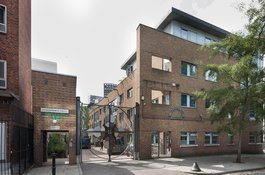
Dellow Centre from the north, August 2017
Contributed by Derek Kendall
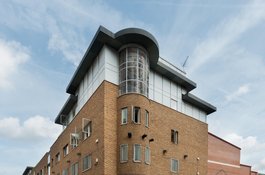
Dellow Centre from Gunthorpe Street, August 2017
Contributed by Derek Kendall
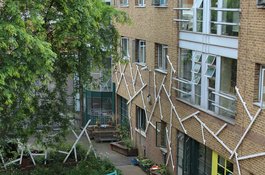
The courtyard of the Dellow Centre
Contributed by Survey of London
.jpg.265x175_q85_crop-0%2C0.jpg)
The kitchen of Providence Row
Contributed by Survey of London
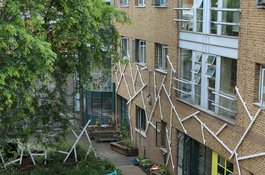
The courtyard of the Dellow Centre
Contributed by Survey of London
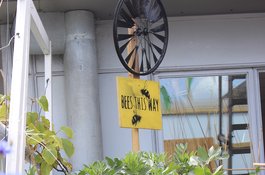
Rooftop garden on the Dellow Centre
Contributed by Survey of London

The rooftop garden of the Dellow Centre
Contributed by Survey of London
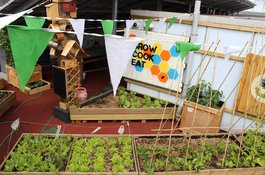
The rooftop garden of the Dellow Centre
Contributed by Survey of London
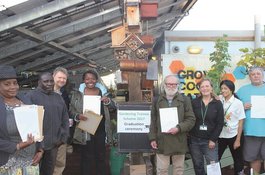
The rooftop garden of the Dellow Centre
Contributed by Survey of London

The kitchen of Providence Row
Contributed by Survey of London
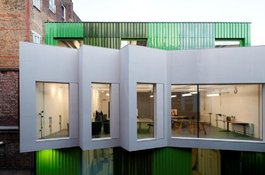
New building for Providence Row
Contributed by Survey of London